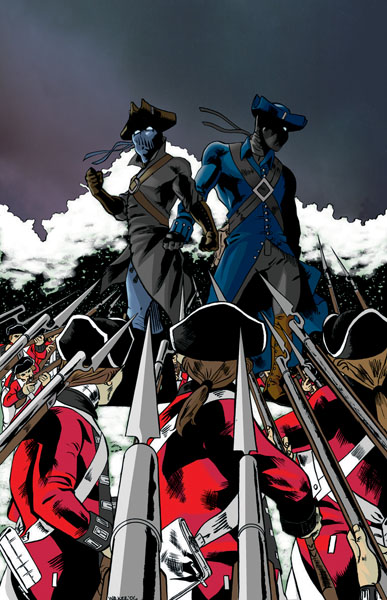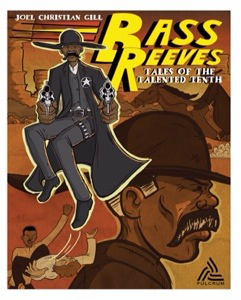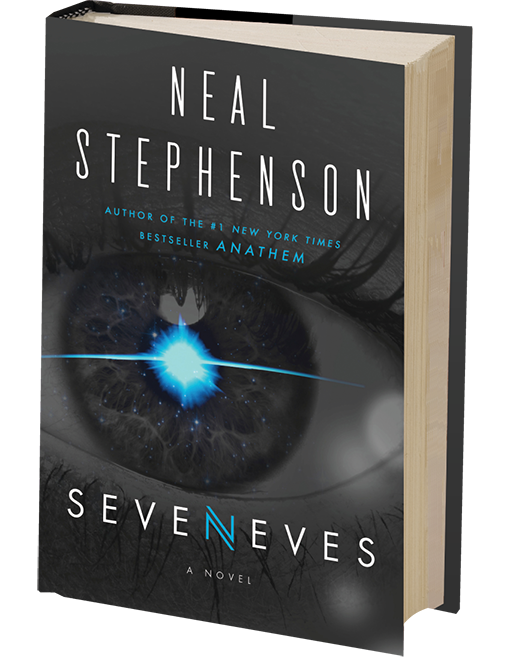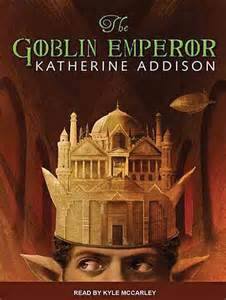Graphic Novel Review by Kerey McKenna
This is the third in a series of Nerds who Read Graphic Novel Reviews dedicated to Black History Month.
I was hoping that The Sons of Liberty would offer something new to the historical fantasy and comic superhero genre by setting its action in the years leading up to the American Revolution, but I found the execution somewhat lacking.
The story begins promisingly enough in 1776 with a raid on a loyalist compound by two mysterious figures. Their faces are obscured by tri-corn hats and black masks but their eyes crackle with electric sparks and they demonstrate agility and strength far beyond those of mortal men. However before we can begin what the narrator assures will be an epic battle…the rest of the book is a flashback/origin story for our mysterious heroes. Winding the narrative back several years the story takes us to the plight of Graham and Brody, run-away slaves in colonial-era Pennsylvania who fall into the clutches of William Franklin, evil bastard son of Benjamin Franklin. For the story the bastard William (yes he was actually a bastard, but Benjamin ‘recognized him’ as a son and helped advance his career in the British colonial civil service) has been upgraded to a mustache-twirling villain. Perverting the studies of electricity performed by his father, William not only electrocutes every barnyard animal he can get his hands on, but also snatches up the fugitive boys to use in his in-human experiments. Electrocuted and left for dead, the boys are discovered by Benjamin Franklin and the abolitionist dwarf Benjamin Lay. They hide with the hermit Lay, who instructs them in the African martial art of Dambe (Lay having been upgraded to abolitionist Yoda). They also discover that the Bastard Franklin’s experiments have granted them extraordinary powers, the implication being that Graham and Brody will one day become the dynamic duo we saw in the action cold open. Despite using their powers to get revenge on their former master and his slave hunter, the boys are shunned and feared by their peers due to their unnatural powers and the very real concern that they will all be killed in the ensuing retaliation to any perceived slave rebellion.
There is a lot of promise in this book, but I felt like it was hampered by pacing issues and peculiarities in the artwork. This first volume carries a heavy burden of world building, introducing the audience to pre-revolution America, the horrors of the slave trade, the early abolitionist movement, and Benjamin Franklin’s relationship with his evil bastard son.
The narrative foot-dragging in getting to the supernatural and alternate history elements isn’t aided by the uneven art. Steve Walker’s drawings work well in creating coherent action scenes (such as the boys escaping vicious hunting dogs that have been sent to track them down), but sometimes his work on faces and anatomy doesn’t quite pull together. Often enough when the faces slip into the uncanny valley this may be because the colorization used by Oren Kramek suggests that the whole art team is learning as they go; sometimes the colors work and in other panels they clash in such a way that it is hard for the eye to follow.
All that being said, the book never falls completely flat and superhero franchises have been launched on much shakier first installments than this one. As I said, it appears that the art team may be learning on the job, but they do appear to be improving. While not my top recommendation, it may be something to throw the way of a reader (particularly a young adult or tween) that needs a little nudge from action and science fiction to get more interested in history. If I come across it, I may pick up the second volume, Death & Taxes, to see if the rough edges have smoothed out.
Kerey McKenna is a contributing reviewer to Nerds who Read and SMOF for the annual Watch City Steampunk Festival, coming to Waltham, Massachusetts on May 7, 2016. Learn more at www.watchcityfestival.com.
 Living most of my life in Massachusetts, I count myself lucky to have visited many locations crucial to the Revolutionary War and the founding of the United States. As a fan of science fiction and fantasy, I have always been slightly disappointed by the lack of fantastical spins on our nation’s founding era. In American alternate history stories, the War of Independence trails a distant third to World War II and the Civil War for novels created out of “what if” scenarios and war gaming. A fascination with the historical old west has produced plenty or weird west tales and cowboy ghost stories. The demand for more steampunk is currently mining every buried lump of story potential from America’s industrial years. But it seems like fantastical takes on our founding are few and far between. Perhaps as other historical periods become overdone though, more creators will find fertile ground in this era of rebellion. The Assassin’s Creed 3 video game and several of its spinoffs were set against the backdrop of the American Revolution, and Fox’s supernatural action show Sleepy Hollow re-imagines Washington Irving’s hapless schoolteacher as a swashbuckling spy charged with preventing the British from winning the war through dark magic.
Living most of my life in Massachusetts, I count myself lucky to have visited many locations crucial to the Revolutionary War and the founding of the United States. As a fan of science fiction and fantasy, I have always been slightly disappointed by the lack of fantastical spins on our nation’s founding era. In American alternate history stories, the War of Independence trails a distant third to World War II and the Civil War for novels created out of “what if” scenarios and war gaming. A fascination with the historical old west has produced plenty or weird west tales and cowboy ghost stories. The demand for more steampunk is currently mining every buried lump of story potential from America’s industrial years. But it seems like fantastical takes on our founding are few and far between. Perhaps as other historical periods become overdone though, more creators will find fertile ground in this era of rebellion. The Assassin’s Creed 3 video game and several of its spinoffs were set against the backdrop of the American Revolution, and Fox’s supernatural action show Sleepy Hollow re-imagines Washington Irving’s hapless schoolteacher as a swashbuckling spy charged with preventing the British from winning the war through dark magic.

 Keen-eared aficionados of American Jazz, Rock, and R&B might recognize the name Stagger Lee (or Stagolee) as a legendary outlaw. He entered the American mythology when he shot down card sharp Billy Lyons in an old west Texas saloon. Or was it because Billy Lyons was sleeping with Stagolee’s woman and it wasn’t Texas but the gold mines of California? And was it because Billy messed with Stag’s wife or Stag’s Stetson hat? Or was it an act of self-defense in a bar brawl in Mississippi? Or was it Georgia? Were Lyons and Lee not figures of the 1890’s but rival pimps in 1970’s Detroit? Over the years Lloyd Price, Fats Domino, Wilson Pickett, Bob Dylan, Jerry Lee Lewis, Ike and Tina Turner, and the Grateful Dead have been just a few of the musicians to sing Stagger Lee’s song of murder and revenge.
Keen-eared aficionados of American Jazz, Rock, and R&B might recognize the name Stagger Lee (or Stagolee) as a legendary outlaw. He entered the American mythology when he shot down card sharp Billy Lyons in an old west Texas saloon. Or was it because Billy Lyons was sleeping with Stagolee’s woman and it wasn’t Texas but the gold mines of California? And was it because Billy messed with Stag’s wife or Stag’s Stetson hat? Or was it an act of self-defense in a bar brawl in Mississippi? Or was it Georgia? Were Lyons and Lee not figures of the 1890’s but rival pimps in 1970’s Detroit? Over the years Lloyd Price, Fats Domino, Wilson Pickett, Bob Dylan, Jerry Lee Lewis, Ike and Tina Turner, and the Grateful Dead have been just a few of the musicians to sing Stagger Lee’s song of murder and revenge.
 For Black History Month, I thought I’d post some reviews of books and graphic novels featuring and/or created by African Americans. First up is the graphic novel Tales of the Talented Tenth, Vol. 1: Bass Reeves. This biography covers the formative years and career highlights of the title character, an escaped black slave who went on to have a prolific career as a lawman in the Wild West. Reeves is often cited as having captured over 3,000 fugitives from justice, the highest rate of the era. Frequently overlooked in earlier whitewashed narratives of the Old West, Reeves’s amazing story is beginning to gain more recognition in both history and fiction.
For Black History Month, I thought I’d post some reviews of books and graphic novels featuring and/or created by African Americans. First up is the graphic novel Tales of the Talented Tenth, Vol. 1: Bass Reeves. This biography covers the formative years and career highlights of the title character, an escaped black slave who went on to have a prolific career as a lawman in the Wild West. Reeves is often cited as having captured over 3,000 fugitives from justice, the highest rate of the era. Frequently overlooked in earlier whitewashed narratives of the Old West, Reeves’s amazing story is beginning to gain more recognition in both history and fiction.
 The composer Rossini once said that Wagner’s operas have great moments but awful quarter hours. Apparently what’s true of Grand Opera is also true of Space Opera. For although Neal Stephenson’s Seveneves features captivating characters on spectacular adventures, between the adventures are vast stretches of emptiness, much like space itself.
The composer Rossini once said that Wagner’s operas have great moments but awful quarter hours. Apparently what’s true of Grand Opera is also true of Space Opera. For although Neal Stephenson’s Seveneves features captivating characters on spectacular adventures, between the adventures are vast stretches of emptiness, much like space itself. A strong showing from first time author Katherine Addison, The Goblin Emperor is an enthralling tale of court intrigue set inside the royal palace of an Elven Steampunk Empire (or perhaps more accurately, a Dungeon/Magic-Punk Empire).
A strong showing from first time author Katherine Addison, The Goblin Emperor is an enthralling tale of court intrigue set inside the royal palace of an Elven Steampunk Empire (or perhaps more accurately, a Dungeon/Magic-Punk Empire).